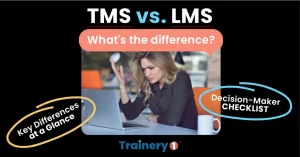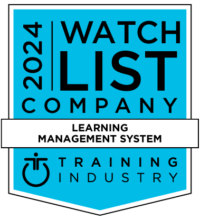While the move toward remote training and learning and development (L&D) functions isn’t new, the pandemic drastically accelerated the shift, with nearly 85% of L&D programs moving from in-person to virtual. Even before the COVID-19 pandemic, LinkedIn Learning’s “Workplace Learning Report” found that companies were already planning to spend far less on instructor-led training (down 38%) and to invest more in online learning (up 57%).
Blended learning offers the best of both worlds: eLearning technology to streamline training management and make learning more accessible, along with in-person instruction for skill development. It’s the ideal scenario for learners who retain information better when they learn it in an instructor-led setting — and for administrators looking to improve efficiency and economy. In fact, a full one-third of large companies and one-fourth of small and medium-sized businesses (SMBs) already rely on blended learning methods.
Until recently, most learning technologies were created for either fully digitized online learning or fully traditional face-to-face classroom settings. As a result, management of the hybrid environment was cumbersome and lacked integration. These siloed systems make it nearly impossible to maintain accurate and auditable records. Plus, managing two systems is inefficient and time-consuming — a significant problem when lack of staff resources is the most common reason for “uneven support for L&D.”
Fortunately, many online and mobile tools have come on the market that help administrators better manage in-person instructor-led courses, blended training programs and eLearning. Here are seven noteworthy technologies that can help instructors and training consultants streamline processes, improve records management and reduce compliance risk — all while improving the learner’s and administrator’s experience.
1. Training Marketing Management
Over half of employees told LinkedIn Learning they would spend more time learning if their managers recommended specific courses to them, suggesting that many don’t participate because they aren’t aware of what they need or what’s available. Meanwhile, L&D professionals say they spend 16% of their time “promoting learning programs to employees.” Clearly, there’s a gap in reaching learners despite the hard work training administrators put into spreading the word.
New online tools enable administrators delivering hybrid programs to create, promote and manage online and in-person training events all in one place. These platforms help blended learning instructors, executive coaches and training consultants create and send promotional emails and invitations for upcoming events, courses and sessions. They can also use mobile capabilities to verify in-person attendance and completion.
2. Automated Course Authoring Tools
L&D professionals spend nearly one-third of their time building or sourcing content, according to the LinkedIn Learning report. Anything that streamlines the process while ensuring high-quality, appropriate and relevant content can make training professionals significantly more efficient.
To streamline course creation, automated course authoring tools enable content developers to assemble programs from pre-built curriculum modules. Administrators can choose from relevant topics and course materials to create new programs and update existing curricula quickly — an especially important feature for health and safety training and human resources (HR) compliance programs. These solutions accelerate time to delivery by eliminating time-consuming content development processes.
3. Online Video Libraries
According to Omnipress’ 2019 “Training Trends Report,” about half of training professionals say their organization covers 11 or more different topics or disciplines in its training programs. Maintaining such a broad and diverse selection of content can be difficult, especially as video has become such a significant element of hybrid training programs. The production time involved can slow time to market such that, in some cases, it might be outdated by the time it’s completed (for example, COVID-19 compliance or state-required sexual harassment training).
Leveraging online video libraries helps blended learning program administrators to deliver the latest content to learners without having to produce it themselves. In blended learning environments, access to video libraries means that learners can consume background information at their convenience and come to training events having already completed prerequisite instruction. Trainers can also incorporate video content into face-to-face events.
These platforms not only make content more accessible, but the best also offer user-friendly dashboards for training professionals to track and verify participation and even gain per-module engagement analytics for online learners. Organizations can integrate this data directly into learning management systems (LMSs) to ensure up-to-date records for every learner, across every delivery method.
4. Responsive Design
In many offline training situations, instructors must wait until they are back in the office to update records in a spreadsheet or on-premises system. There’s also no way to verify compliance records on the shop floor if there is an immediate issue.
But, as the world has gone mobile, so have training tools, making them perfectly suited for blended learning. Responsive design — which refers to a platform’s ability to display and function properly across mobile phones, tablets and laptops — enables L&D professionals to manage and deliver training, document attendance, and verify certifications from the office, at home or on a plant floor. The newest tools offer stand-alone apps for use even with an LMS, which not only makes blended learning management simpler but also reduces the risk of errors in documentation.
5. Digital Signature Capture
Verifying training attendance and participation is an important part of maintaining compliance, but using paper to capture in-person training signatures is cumbersome. Not only does the trainer run the risk of losing the paper, but there’s also privacy and storage issues to consider. It’s also antiquated, and the low-tech appearance can detract from perceived training quality.
Instead, blended learning instructors can easily capture attendees’ e-signatures on a phone or tablet at in-person training to verify attendance. While many LMS and training management platforms offer this capability, it can also easily be added as a stand-alone tool. Adopting this simple yet powerful capability eliminates the hassle of paper, creates a digital and auditable trail for compliance, and streamlines trainee management and trainer processes.
6. Real-time Compliance Tracking
Blended learning can make it difficult to maintain and access current, accurate compliance certifications across multiple offices and departments. Using an automated compliance tracking system dramatically lowers risk. These tools can generate automated alerts about who needs to be recertified and when, so that organizations can offer training and learners can complete it proactively. That way, no one falls through the cracks. To keep data current, these platforms can integrate with online learning and face-to-face attendance management systems to ensure timely, accurate data and automatically send proof of completion to the appropriate managers.
7. Learner Analytics: Blended Style
Among the top strategic priorities for 2020 for L&D professionals, according to the LinkedIn Learning report, “evaluating the impact of learning” (38%) and “increasing learner engagement” (35%) ranked first and second. Measuring the effectiveness of blended learning is crucial for ensuring learners are retaining training and applying it on the job, but blending offline and online methodologies can be challenging. Administrators often do not have the resources to collate data, analyze it and draw actionable insights.
Using digital tools to measure engagement for both online and face-to-face training can help L&D professionals understand what works and what doesn’t. For online learning, tools that automatically measure the time learners spend on specific topics or components can help training administrators identify curriculum weaknesses and lack of engagement. For in-person learning, following up with online quizzes can help them gauge the impact and retention of learning and make adjustments as necessary. Digital integration enables L&D professionals to analyze both types of results together, providing them with a clearer picture of training effectiveness and business impact.
The expanding role of cloud technology is making state-of-the-art tools more accessible for all fields and all types of learning environments, including face-to-face and blended learning. Many are modular, flexible and able to grow as program needs dictate. In addition, there is usually no need to dump current digital tools — most cloud platforms accept application programming interface (API) integrations that can expand capabilities while providing seamless, easy-to-use workflows.
Bringing digital tools into the face-to-face and blended training environment accelerates efficiency, improves the learner experience and lowers compliance risk — while maintaining that personal touch.







